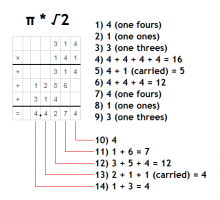I assure you powers are not beyond you conceptually. The computation of fractional powers is burdensome, which is why logarithms, slide rules, and calculators were invented. But calculators have been invented so forget the computation and understand the concepts.
We start with powers that are natural numbers defined as 0, 1, 2, 3, and so on. And, to avoid having to deal with special cases, we talk about the powers of a number greater than zero called the base. We do not restrict the kind of number that is the base except to say it is greater than zero. Let’s call the base b and the power (also called the exponent) p. So b to the p power is written out as [imath]b^p[/imath] or [imath]b[/imath]^[imath]p[/imath].
Remember that initially we are restricting the exponents to whole numbers starting with zero.
The formal definition then is
[math]\text {If } p = 0, \text { then } b^p = 1, \text { but}\\ \text {if } p > 0, \text { then } b^p = b * b^{(p - 1)}.[/math]
So, for example,
[math]3^0 = 1;\\ 3^1 = 3 * 1 = 3;\\ 3^2 = 3 * 3 = 9;\\ 3^3 = 3 * 9 = 27 = 3 * 3 *3;\\ 3^4 = 3 * 27 = 81 = 3 * 3 * 3 * 3;\\ 3^5 = 3 * 81 = 243 = 3 * 3 * 3 * 3 * 3;\\ 3^6 = 3 * 243 = 729; \text { and so on forever.}[/math]
Now remember that the only restriction we placed on b is that it is greater than zero.
So for another example,
[math]\left ( \dfrac{1}{2} \right )^0 = 1;\\ \left ( \dfrac{1}{2} \right )^1 = \dfrac{1}{2};\\ \left ( \dfrac{1}{2} \right )^2 = \dfrac{1}{2} * \dfrac{1}{2} = \dfrac{1}{4};\\ \left ( \dfrac{1}{2} \right )^3 = \dfrac{1}{2} * \dfrac{1}{2} * \dfrac{1}{2} = \dfrac{1}{2} * \dfrac{1}{4} = \dfrac{1}{8}, \text { and so on.}[/math]
So, using the definitions rather than the calculator, what is [imath]0.4^4[/imath]?
Next up, we go for the laws of powers, but are you on board up to here?
We start with powers that are natural numbers defined as 0, 1, 2, 3, and so on. And, to avoid having to deal with special cases, we talk about the powers of a number greater than zero called the base. We do not restrict the kind of number that is the base except to say it is greater than zero. Let’s call the base b and the power (also called the exponent) p. So b to the p power is written out as [imath]b^p[/imath] or [imath]b[/imath]^[imath]p[/imath].
Remember that initially we are restricting the exponents to whole numbers starting with zero.
The formal definition then is
[math]\text {If } p = 0, \text { then } b^p = 1, \text { but}\\ \text {if } p > 0, \text { then } b^p = b * b^{(p - 1)}.[/math]
So, for example,
[math]3^0 = 1;\\ 3^1 = 3 * 1 = 3;\\ 3^2 = 3 * 3 = 9;\\ 3^3 = 3 * 9 = 27 = 3 * 3 *3;\\ 3^4 = 3 * 27 = 81 = 3 * 3 * 3 * 3;\\ 3^5 = 3 * 81 = 243 = 3 * 3 * 3 * 3 * 3;\\ 3^6 = 3 * 243 = 729; \text { and so on forever.}[/math]
Now remember that the only restriction we placed on b is that it is greater than zero.
So for another example,
[math]\left ( \dfrac{1}{2} \right )^0 = 1;\\ \left ( \dfrac{1}{2} \right )^1 = \dfrac{1}{2};\\ \left ( \dfrac{1}{2} \right )^2 = \dfrac{1}{2} * \dfrac{1}{2} = \dfrac{1}{4};\\ \left ( \dfrac{1}{2} \right )^3 = \dfrac{1}{2} * \dfrac{1}{2} * \dfrac{1}{2} = \dfrac{1}{2} * \dfrac{1}{4} = \dfrac{1}{8}, \text { and so on.}[/math]
So, using the definitions rather than the calculator, what is [imath]0.4^4[/imath]?
Next up, we go for the laws of powers, but are you on board up to here?

